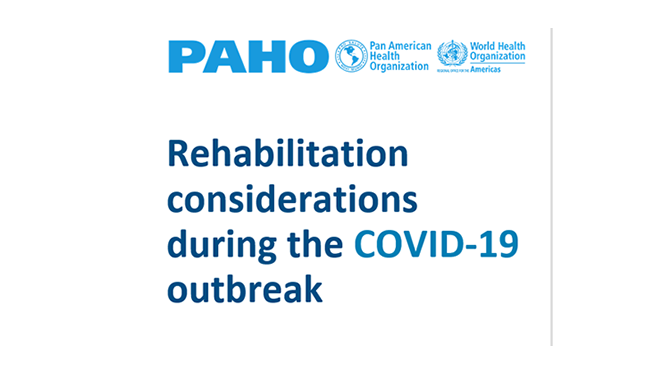Rehabilitation considerations during the COVID-19 outbreak
In March 2020 the World Health Organization (WHO) declared the outbreak of a novel coronavirus disease (COVID-19), caused by the severe acute respiratory syndrome coronavirus 2 (SARS-CoV-2), to be a pandemic. Across the Region of the Americas all countries and territories have reported cases of COVID-19. WHO, PAHO and public health authorities around the world are taking action to contain the spread of COVID-19 and manage its impact.
While most people develop mild or uncomplicated forms of COVID-19, it is estimated that approximately 14% are associated with severe acute respiratory infection (SARI) and may require hospitalization and oxygen support, and 5% require admission to an intensive care unit (ICU).1 Early reports from China indicate median (IQR) ICU lengths of stay for patients admitted with COVID-19 of 8.0 (4.0–12.0)2 and 8.0 (4.0–11.0)3 days.
Rehabilitation improves the health outcomes of patients with severe cases of COVID-19 and benefits health services through:
− Optimizing health and functioning outcomes: Rehabilitation may reduce complications associated with admission to an ICU, such as post intensive care syndrome (PICS);4 it aims to optimize a patient’s recovery and reduce the experience of disability. Rehabilitation interventions can help address many consequences of severe COVID-19, including physical, cognitive, and swallow impairments, and provide psychosocial support. Older patients, and those with pre-existing health conditions, may be more vulnerable to the effects of severe illness, and rehabilitation can be particularly beneficial for maintaining their prior levels of independence.
− Facilitating early discharge: Where there is high demand for hospital beds, patients may need to be discharged more rapidly than ordinarily. Rehabilitation is particularly important in preparing patients for discharge, coordinating complex discharges, and in ensuring continuity of care.
− Reducing the risk of readmission: Rehabilitation helps to ensure patients do not deteriorate following discharge and require readmission, which is critical in the context of hospital bed shortages.







